On average, it takes the United States one and a half years to negotiate a free trade agreement, as a review of 20 such deals by the Peterson Institute for International Economics found. US Commerce Secretary Wilbur Ross has said that he hopes the renegotiation of the North American Free Trade Agreement (NAFTA) can be completed by the end of this year.
That timeline — shorter than all but one other free trade agreement negotiation, a pact the United States negotiated with Jordan in four months — was described as “staggering” by a Canadian close to the talks. It would give representatives just 4.5 months to reach agreement on everything from changes to sourcing requirements for manufactured goods to the addition of chapters on labour, environment and the digital economy.
Mexican officials concur that they would like to see the talks concluded well before the country’s presidential elections in July 2018. Gerónimo Gutiérrez, US ambassador to Mexico, has said: “The three governments share the view that every effort should be made possible to finish this year and at least achieve substantive agreements that would largely limit the uncertainty that we still have.”
The first of what is expected to be seven rounds of talks is slated to last August 16–20 in Washington, DC, kicked off by a high-level dinner on the eve of talks. The second round will be hosted in Mexico around September 10, and Canada will host the third round.
The stakes are high. Trade between the three nations has grown from $US432 billion in 1993 to $US1.2 trillion in 2016. Canada and Mexico are by far the top US export markets, absorbing more than one-third of all goods and services traded by the United States.
American farmers, in particular, have been a major beneficiary of the agreement. They’ve seen their exports to Canada and Mexico increase 300 percent since NAFTA was enacted, according to the American Farm Bureau. In meetings with senators, governors and administration officials, the powerful farm lobby has urged policy makers not to upend the agricultural section of the accord.
What an Aggressive Timeline Looks Like
If negotiators were to stick to the timeline that’s been laid out and insist on concluding negotiations by year-end, they would have to significantly narrow the scope of the discussions, experts say. “Maybe they’ll tweak a few things,” says Monica de Bolle, a trade expert at the Peterson Institute for International Economics, “and call it a day.” She expects a different outcome, though. “If the premise is to reduce the US trade deficit, nothing’s going to get done by the end of the year, so that leads me to think that the process will likely drag on.”
Mexican Economy Minister Ildefonso Guajardo has argued that reduction of the trade deficit, the number-one objective advanced by the United States, would need to be achieved “by expanding commerce, not reducing it.” The United States has said it wouldn’t seek tariff increases, but “trade remedies would be one way that the administration could try to address the deficit,” says Kellie Meiman Hock, managing partner at McLarty Associates, a strategy consultancy.
All three countries have agreed that there’s room to “modernize” NAFTA, and to include provisions that address the growing digital economy. While there is general agreement on adding sections on labour and the environment to the pact, getting to specific language that all three countries can agree on could be challenging and time-consuming.
Other issues will be even more contentious. The United States wants to drop Chapter 19, which created a bilateral panel to hear a member country’s claims that another is selling a good below its cost or for less the price charged in the home country. Canada has won a number of these disputes with the United States, so it is expected to strongly resist the wholesale elimination of this chapter, as is Mexico. Canada’s top diplomat, Chrystia Freeland, has strongly implied she is ready to walk away from the table over the issue.
The United States will also be advancing its objective of increasing the amount of American-made content in manufactured goods crossing the border. “That could be very difficult from the point of view of Canada and Mexico, which are unlikely to accept anything like that,” says de Bolle. A series of reports, from think tanks such as the Peterson Institute and the Centre for International Governance Innovation, have called for taking the reverse tack — loosening, instead of tightening, these “rules of origin.”
But the political calculus in the United States makes that a tough sell as a negotiating strategy for the American team. “Because the whole rules of origin issue is tied to this reduction-of-the-trade-deficit idea, tightening rules of origin would be a selling point for the Trump administration, because they’d be able to say we have done something that will presumably help the auto sector in the US,” says de Bolle.
Changing the rules of origin could significantly disrupt manufacturers. Supply chains have become much more regionally integrated since NAFTA was implemented, and making major changes to them would likely be costly and difficult.
Despite the skepticism about concluding talks by December, many trade experts are cautiously optimistic that the differences between the three countries over the substantive issues dividing them can ultimately be negotiated to a mutually acceptable resolution, provided the political stars align.
“I think there’s a real possibility for this to be successfully concluded,” says Josh Meltzer, a trade expert at the Brookings Institution, “but it’s going to take considerably more time than this nominal end date of the end of the year.” Successful negotiations, he said, would end with an agreement that further reduces trade barriers, better integrates the three economies, and includes rules in areas currently unaddressed, such as on digital trade and state-owned enterprises, which will almost certainly take time.
Canadian officials said a serious revamp of NAFTA that fully modernizes the agreement would likely take two years, and despite the tight timeline being currently projected, negotiators have left the door open to extending the talks.
While the US Trade Representative Robert Lighthizer has acknowledged the political pressure for a quick deal, he has left the door open to a longer negotiating horizon, saying: “We’re not going to have a bad agreement to save time.”



